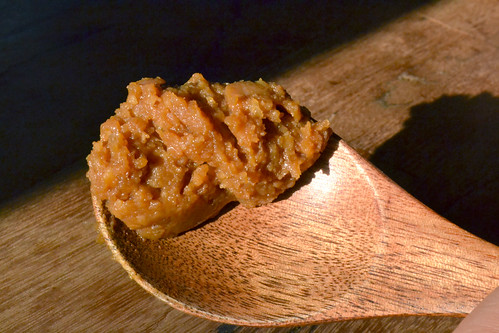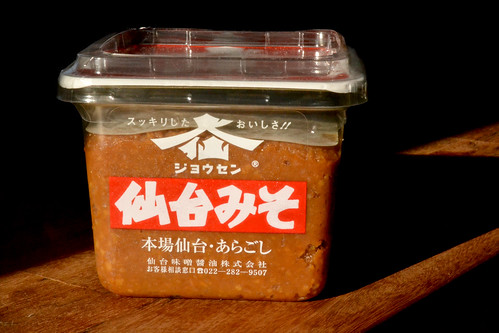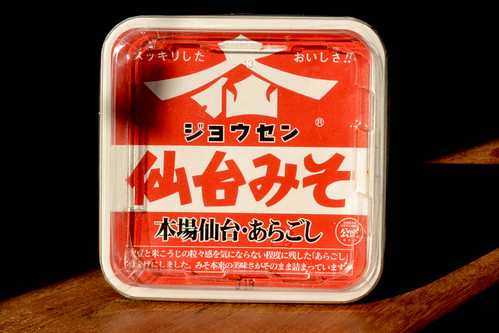
Before the 2011 Tohoku Earthquake and Tsunami,
Sendai was a city that made my favorite miso. One tablespoon of Sendai miso goes into my dashi every morning for a breakfast consisting of miso-shiru, rice and umeboshi. In recent weeks, Sendai has come to symbolize much more to me than just a great producer of miso, gyutan (beef tongue) and oysters.
But because my closest connection to Sendai is the miso that I put into my body daily, I'd like to elaborate on their miso.
In the past year, I have had the opportunity to try many different brands of miso available in the U.S. Out of all the misos I have tried in the U.S.
Sendai Miso is my favorite.

It's definitely pricier than the domestic varieties and some imported brands of miso available at my local Japanese market, but it's worth it. The problem with a lot of darker misos is that they can seem too salty. Sendai miso possesses a good balance--a commanding presence without being abrasive. Sendai miso's suppressed saltiness is due to a longer fermentation than other red misos.

Sendai miso's history started when the samurai
Date Masamune built a miso factory at the base of the Sendai Castle way back in 1593. In those days most of the miso was made right in the city, but nowadays, Sendai miso is produced all over
Miyagi Prefecture. The dry, mild taste is a consequence of just two ingredients, rice kōji and soybeans fermented over a long period of time. Sendai miso can be enjoyed by itself because of its mild flavor. Because of this, some people refer to Sendai miso as
namemiso ("lickable miso").

Although I use other misos like Saikyo for shira-ae and marinades, Sendai miso is the kind I will always have stocked in my fridge for miso soup.
 Before the 2011 Tohoku Earthquake and Tsunami, Sendai was a city that made my favorite miso. One tablespoon of Sendai miso goes into my dashi every morning for a breakfast consisting of miso-shiru, rice and umeboshi. In recent weeks, Sendai has come to symbolize much more to me than just a great producer of miso, gyutan (beef tongue) and oysters.
But because my closest connection to Sendai is the miso that I put into my body daily, I'd like to elaborate on their miso.
In the past year, I have had the opportunity to try many different brands of miso available in the U.S. Out of all the misos I have tried in the U.S. Sendai Miso is my favorite.
Before the 2011 Tohoku Earthquake and Tsunami, Sendai was a city that made my favorite miso. One tablespoon of Sendai miso goes into my dashi every morning for a breakfast consisting of miso-shiru, rice and umeboshi. In recent weeks, Sendai has come to symbolize much more to me than just a great producer of miso, gyutan (beef tongue) and oysters.
But because my closest connection to Sendai is the miso that I put into my body daily, I'd like to elaborate on their miso.
In the past year, I have had the opportunity to try many different brands of miso available in the U.S. Out of all the misos I have tried in the U.S. Sendai Miso is my favorite.
 It's definitely pricier than the domestic varieties and some imported brands of miso available at my local Japanese market, but it's worth it. The problem with a lot of darker misos is that they can seem too salty. Sendai miso possesses a good balance--a commanding presence without being abrasive. Sendai miso's suppressed saltiness is due to a longer fermentation than other red misos.
It's definitely pricier than the domestic varieties and some imported brands of miso available at my local Japanese market, but it's worth it. The problem with a lot of darker misos is that they can seem too salty. Sendai miso possesses a good balance--a commanding presence without being abrasive. Sendai miso's suppressed saltiness is due to a longer fermentation than other red misos.
 Sendai miso's history started when the samurai Date Masamune built a miso factory at the base of the Sendai Castle way back in 1593. In those days most of the miso was made right in the city, but nowadays, Sendai miso is produced all over Miyagi Prefecture. The dry, mild taste is a consequence of just two ingredients, rice kōji and soybeans fermented over a long period of time. Sendai miso can be enjoyed by itself because of its mild flavor. Because of this, some people refer to Sendai miso as namemiso ("lickable miso").
Sendai miso's history started when the samurai Date Masamune built a miso factory at the base of the Sendai Castle way back in 1593. In those days most of the miso was made right in the city, but nowadays, Sendai miso is produced all over Miyagi Prefecture. The dry, mild taste is a consequence of just two ingredients, rice kōji and soybeans fermented over a long period of time. Sendai miso can be enjoyed by itself because of its mild flavor. Because of this, some people refer to Sendai miso as namemiso ("lickable miso").
 Although I use other misos like Saikyo for shira-ae and marinades, Sendai miso is the kind I will always have stocked in my fridge for miso soup.
Although I use other misos like Saikyo for shira-ae and marinades, Sendai miso is the kind I will always have stocked in my fridge for miso soup.




Comments (2)
Do you have Sendai Miso Stock, currently ?
How much the price ?
Is the Sendai miso safe from radioactivity?